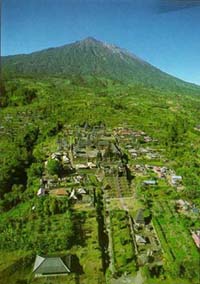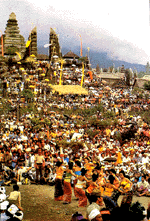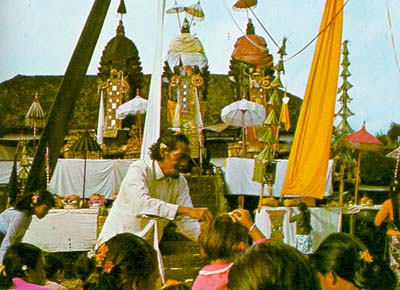
Besakih Temple
|
|
A climb
north, through
the astonishing landscapes of Bukit Jambul, ascends over 900 meters up
the slopes of Gunung Agung to Pura Besakih, the holiest of all temples
in Bali. It originated most probably as a prehistoric terraced
sanctuary where worship and offerings were made to the god of Gunung
Agung, the dominant landscape element in the Balinese world. Over a
thousand years and more, it was enlarged and added to until it grew
into the present complex of about 30 temples.
|

|
|
In the
10th century it
was apparently a state temple. According to inscriptions kept here, an
important event took place in the year 1007. If can only be guessed
that this was associated with death rituals for Queen Mahendradatta,
Udayana's co-ruler who died the previous year. Since the 15th century
it was the state temple of the Geigel-Kiungkung dynasty which built a
series of small temples in honor of its deified rulers. Now it is the
state temple for the provincial and national governments which meet all
expenses. Today, Pura Besakih is revered by all Balinese as the "mother
temple" of Bali.
|
|
Within the
Besakih
complex, the paramount sanctuary is the Pura Panataran Agung which
rears its lofty merus on a high bank of terraces, steps ascend in a
long perspective to the austere split gate.
|

|

|
Inside the
main
courtyard stands the three-seated shrine enthroning the Trisakti, the
trinity of Brahma, Visnu and Siwa. During festivals the shrines are
wrapped in colored cloth symbolic of the deities.
|
|
The Pura
Panataran Agung
and two other important temples higher up the slope likewise together
symbolize the Trisakti. In the center Pura Panataran Agung is hung with
white banners for Siwa; to the right, Pura Kiduling Kreteg vyith red
banners for Brahma; and Pura Batu Mddeg, to the left, with black
banners for Visnu.
|
|
These
latter two temples
are taken care of by the Karangasem and Bangli regencies respectively,
certain other shrines being the responsibility of the other regencies.
All of Bali comes together at Pura Besakih.
|

|
|
Religiously,
oneness is symbolized in the padmasana in Pura Panataran Agung,
dedicated to Sang Hyang Widdhi, the Supreme God.
|

|
|
Pura
Besakih is most
fascinating at festival times, but it is grand and impressive whenever
you go there. The drive up the mountain to Besakih, with a stopover in
Klungkung for sight-seeing and shopping, takes a full day. To resume
the tour of East Bali, if you are staying in Denpasar, it is best to
leave early in the morning the following day. By passing through
Klungkung before noon, you may choose a site to lunch on the beach or
in the shaded countryside and visit the Bat Cave, fishing villages and
Tenganan before reaching Karangasem in mid-afternoon. Now that the new
road linking Rendang and Karangasem has been finished, it is possible
to make a Besakih- Karangaserm round trip comfortably in a day. You may
be lucky to arrive in Bali during a time when eastern villages are
holding ceremonies. Festivals, unique to these villages, should not be
missed, so check the calendar of events at your hotel to find a good
time to visit.
|
Copyright
2001-2015, K&D Bali Designs. All rights reserved.
|